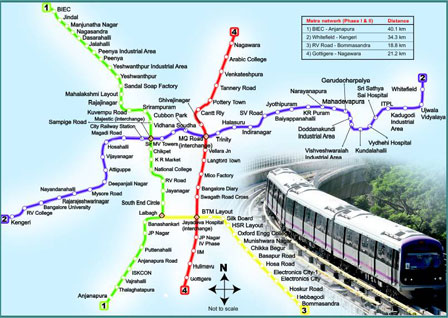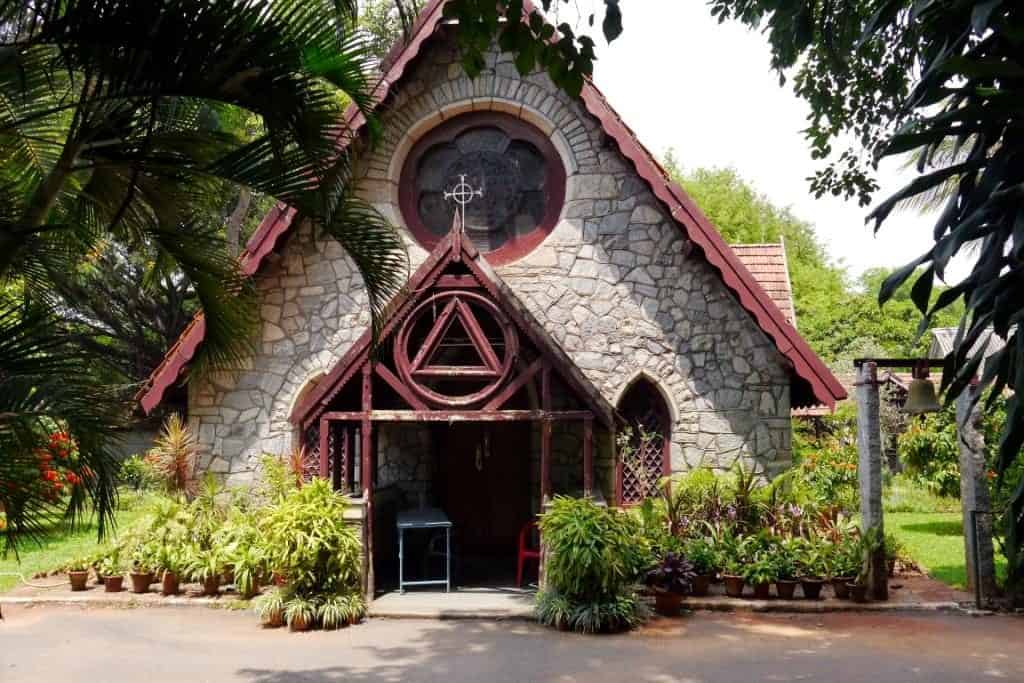“Cutting down trees to build the Metro line just cannot happen without the permission of the Tree Officer,” affirms M K Cholarajappa, Deputy Conservator of Forests (DCF) and Tree Officer, Bruhat Bengaluru Mahanagara Palike (BBMP).
Cholarajappa’s response is a firm and surprising counter to a press note released by the Bangalore Metro Rail Corporation (BMRC) on Friday. The note had announced that the construction of the Vellara Junction station in Richmond Town would not be stopped. This station is along Metro’s Red Line, from Gottigere to Nagawara. Activists had opposed Metro construction here, claiming that it would involve cutting of over 100 trees in the All Saints Church compound.
Opposing BMRC’s announcement, Cholarajappa says, “Even a single tree cannot be cut without the permission of the Tree Officer, according to the Karnataka Tree Preservation Act, 1976.” And if the project involves cutting more than 50 trees, it has to go through a public hearing involving BMRCL, BBMP, church members and other citizens. However, BMRC, in its press release, had claimed that the project would be tweaked so that less than 50 trees would have to be cut (which implies that a public consultation would not be required).
BMRC’s decision even before the site inspection report
Earlier, the decision was to hold a public consultation, and it was even tentatively scheduled for May 20th, says Cholarajappa. But public consultation can be held only after the Tree Officer receives an inspection report from the project site. To put together the inspection report, officials examine the type and condition of the trees that will be affected, and check whether the trees need to be cut, transplanted, or not. Cholarajappa says he has not yet got the inspection report, and hence the public consultation would most probably be postponed.
“Without our green signal, how could the BMRCL take the decision (to go ahead with the project) and inform this to the dailies?” asks the DCF.
BMRC’s claim that fewer than 50 trees would be affected, has raised suspicions among the protestors too. Franklin K S, a member of All Saints Church and of the green brigade that’s protesting the land acquisition, does not believe BMRC’s claim. He refers to authorities’ practice of dividing the trees to be cut, into packages of 50 or lesser, so as to avoid public consultation. Citizen Matters had recently highlighted that hundreds of trees had been chopped for Metro and other public projects in Bengaluru using this loophole in the Tree Preservation Act, avoiding public consultations.
“When institutions want to chop down trees, they will just divide them into different batches. First, they will say that there are just 25 trees, then they will declare that just 40 trees will be affected. However, we have counted and arrived at a figure of over 180 trees,” says Franklin. This tree count was done by botanists associated with the All Saints Church itself.
The number can be confirmed only after the inspection report and public consultation is completed. Currently, even the Tree Officer Cholarajappa is unsure how many trees would have to be cut. Protestors also say that only the Forest Department has the specific criteria to decide on what counts as a tree and not. And hence it’s only the BBMP Forest Department, and not BMRC, that has the authority to declare the number of trees that would be cut, they say.
Besides, as per an interim order on a PIL (WP 17841/2018) on April 23rd, the High Court had ordered that an ‘expert committee’ should be constituted to grant permission for felling trees within BBMP limits. This committee should have experts from the fields of environment, science, technology etc. In case trees have to be felled for public projects, the committee should examine every alternative to save the tree. Only if there is no alternative, should the committee give permission to fell trees, the order had said. BMRC seems to not have considered this court order as well.
No alternative, says BMRC
While protestors demand an alternate plan, BMRC press release says that Vellara Junction station cannot be dropped from its plan. If this station is not built, the distance between Langford and MG Road stations will be 2144 m.
This will deprive Metro facility to commuters from areas like Vellara Junction, Bengaluru Football Stadium, Garuda Mall, Cathedral High School, Sacred Heart Church and St Philomena’s Hospital. Moreover, if the inter-station distance is more than 1500 m, BMRC would have to build an intermediate shaft for ventilation and rescue needs; this too needs land, says the press release.

Vellara Junction station is part of Metro’s Red Line. Credit: BMRC
Loss to the city’s heritage and environment, say protestors
Founded in 1870 by Rev S T Pettigrew, the All Saints Church was originally intended for British pensioners. Today, the sunlight filtering through the tiles of the beautiful ceiling makes it look like a warm and welcoming cottage from a fairytale.
While the BMRC construction will not directly impact the heritage building, Franklin points out that it has been built with limestone and sand. Geophysicists have said that the land here is very rocky. When cranes drill almost 100 metres into the rocky land to construct the station, it would certainly affect the building, says Franklin.
Around 13 species of trees, including Purple Jacaranda, Tamarind, Silver Oak and African Sausage, some of which are even 150 years old, are now under threat from the BMRC. These trees are home to rare birds such as the Paradise Flycatcher, according to Arun Prasad, an environmental and social activist. “There should be a full stop to developmental activity without consultation,” he says.
Build the station, stop temporary acquisition, says church
A month ago, members of the church and the green brigade had jointly filed a petition on Change.org, challenging BMRC’s proposal to construct a “temporary dump yard” in the grounds, axing the heritage trees and dislocating an old age home as well as an opportunity school for children with disabilities. The petition has got almost 31,000 signatures from the public so far.
The petition mentions that the acquisition for the dump yard will impact 60 children in the school here, as well as the 40 residents of the old age home. It says that the beautiful green cover turned into flat land “will be of no use as we cannot plant any deep-rooted trees after the construction.” Also, the entrance to the church and parking areas would get acquired, says the petition. Hence, the petition asks that the BMRC acquire army land or any other land nearby, for the temporary dump yard.

All Saints’ Church. Pic: Rahul Ravi
The petition points out that BMRC’s Detailed Project Report (DPR) had showed that only 200 sqm would be required for the station. It says BMRC has already taken over 3500 sqm of land belonging to the church, which includes commercial areas like Toms Bakery, Fatima Bakery etc., to build the station. Now the corporation is demanding another 4833 sqm land, apparently for the dump yard.
However, BMRCL has said in its press release that the major portion of the church land would be used to construct a permanent, underground station box. On either side, the land that abuts the station box will be used to service tunnel-boring machines. The press release says that only a small area on the church’s northeast side would be temporarily used for “placing cranes and other machinery, mainly during tunnelling activities.”
But an update to the online petition says that the church had never opposed construction of the station itself, and has already given up over 3500 sqm prime land for this. It says that the question is only about the new demand for another 4800 sqm land.
Hence there is lack of clarity on where exactly the station would come up, and the exact purpose of the acquisition proposed now.
The petition update clarifies that the church’s request is to shift the Vellara station by 70-100 metres so that the trees could be saved, and to not acquire the additional land inside church premises.
Franklin says, “We are not against development of the city. However, we want to preserve the few lung spaces that exist here.” He refuses to buy the argument that the design had already been laid and cannot be changed. Moreover, the BMRCL did not even consult the public when the design was drafted; if the Metro is for the public, shouldn’t it ask them first, questions Franklin.
“Check out the tree density in the church premises,” exclaims Joseph Hoover, Convenor of the environmentalist group United Conservation Movement. “Isn’t it next only to Cubbon Park and Lal Bagh? You find that the micro-climate inside the church is 26 degrees, when the temperature outside is 32 degrees. Why should we needlessly destroy the environment?” he asks.
Punati Sridhar, Principal Chief Conservator of Forests (Wildlife), Karnataka, is one of the officials who has been approached by the green brigade. He too strongly opposes the sacrifice of the lung space and heritage grounds for a dump yard. Speaking to Citizen Matters, Sridhar says he has already expressed his opposition, and that only the final public hearing will decide the direction of the plan.
The BMRCL’s announcement that the construction will take place, even before the public hearing, is baffling to the public. There will be clarity on the purpose of the acquisition and the tree loss, only after a public consultation is held.
Trees can be shifted to free space within bangalore, but Roads, Metro,Railways should be constructed for the benefit of the common people. No Institution is above Law of Land.
Many people will be benefited from Metro, Railways and Road due to traffic. Pollution will be reduced.
Very simple
We don’t need metro
We have done enough of infrastructure
Stop tech parks, reduce immigration
That will reduce this increasing he’ll of crowd and chaos
Let’s behave like humans
Everyone..including officers incharge